February 10, 2022
Interview with Resilience Lab Founding Director Anne Browning
1/25/2022 – Graduate Student Assistant Sasha Duttchoudhury sits down with Resilience Lab Founding Director Anne Browning to learn more about the Lab’s history and how the Lab’s vision has changed since its inception in 2015.
Sasha Duttchoudhury: Tell us how the lab got started. What needs and goals was the lab meant to serve?
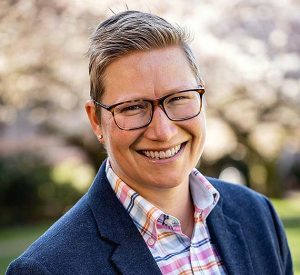
Anne Browning, PhD, MA
UW Assistant Dean of Well-Being
Anne Browning: The lab grew out of work that I had already been doing about students’ access into and transition through their academic experience, really thinking about who gets to experience a sense of belonging within various spaces on campus. There have been moments where we’ve seen folks pivot away from certain areas of academic interest, because they didn’t see themselves represented or didn’t feel as if they really belonged.
For my own dissertation work, I was looking at pathways for student athletes into and through the university. And really, in the first-year transition, one of the things that emerged was that folks were experiencing different levels of resilience in different domains. Folks were very well-trained when they faced challenges and hardship within a sports context… but when they hit academic challenges, they engaged in [what we called] academic self-sabotage. If they were in over their heads academically, we saw students withdraw effort from the academic domain, as an ego protection mechanism. Basically, “It’s easier for me to not try hard at something and fall short than it is to try really hard and go after something, then fall short, because that actually affects my ego.”
So, we had to start thinking about, okay, what’s going on? How do we find ways to help students stay engaged in academic challenges – really, challenges, broadly speaking. We started gathering colleagues from across campus, folks in Housing and Food Services, the Counseling Center, First Year Programs, faculty partners to sit down and really discuss what we were seeing. And it was fascinating that what emerged was in all of these different domains, that there was a real concern around a shift in how students weren’t able to engage in healthy resilience coping…without the skills to assess where they were in the moment and develop healthy help-seeking behaviors. That’s when we decided to create the Lab as a space to have all these conversations around [student] resilience… and there was the snowball effect. We held some meetings, more people would show up, another meeting, more people.
SD: How did you decide to eventually situate the lab within the UAA (Undergraduate Academic Affairs) ? And how did you envision the lab fitting into systems and communities that already existed at UW?
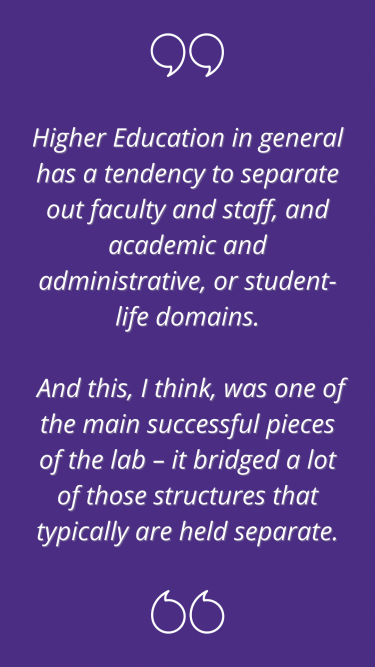 AB: I would say that it was really lucky that I started working on campus in 2002, first athletics and then the UAA in about 2006.
AB: I would say that it was really lucky that I started working on campus in 2002, first athletics and then the UAA in about 2006.
I started running CLUE (Center for Learning and Undergraduate Enrichment) as a study center that we developed into Academic Support Programs, and the UW Resilience Lab grew out of the work in academic support and retention – and I really give Vice Provost Ed Taylor a lot of credit for this – in which, if you had an idea and wanted to be responsive to emerging needs for students, there was a quite a bit of flexibility to try new things within Undergraduate Academic Affairs.
So having a good partnership with Ed and having that structure within the UAA to say, this is what I’m seeing, and I have an idea of what we might try to do. So, the quickness and the agility I think within UAA to really center the student experience was incredibly powerful.
Similarly, by virtue of Undergraduate Academic Affairs being a broader administrative-based entity, it was one of the only spaces in which I saw faculty and staff from all different departments actually engaged in these conversations together. Higher Education in general has a tendency to separate out faculty and staff, and academic and administrative or student life domains. And this, I think, was one of the main successful pieces of the Lab – it bridged a lot of those structures that typically are held separate. And in a way, because we’re thinking about holistic well-being of students, in and out of academic settings, the UAA ended up being a great place to be housed.
SD: Did your own perception of resilience shift? How did working with the lab affect you, personally?
AB: [The Resilience Lab] was a real growing space for me… The research and the work I did around thinking about stereotype threat[1] thinking about senses of belonging, that access and equity lens… And I started taking a right turn, beyond academics, I think we really needed to start thinking about the holistic well-being of students. So, we’ve had that lens in the academic sphere, but it got to a different domain where I realized, “We really need to start thinking more broadly about how folks are showing up in this psychosocial context. Where does mindfulness come into play? Where does compassion come into play, and self-compassion, or lack thereof? How do we actually shift the narrative and shift the conversation away from ‘Am I doing well enough in my first couple years to get into my major of choice’ to a conversation around thriving, that looks a lot different from your GPA?”
And at first, especially in this academic domain, [the question was:] how do we program for students? How do we think about their well-being and program for their well-being? And then the program became about stepping back and realizing that we can’t program for the students if we’re not, as the faculty and staff, paying attention to our own well-being and practicing what we’re advocating for. And so, it became a pivot towards a lot of our time working with faculty and staff on their own well-being and their own resilience. You’re teaching it to folks to become trainers and to work with students, but we see, again and again, the impact of faculty and staff taking this seriously to focus on their own well-being and change how they show up for students. And we felt that this was a pivot from just thinking about resilience for students to really thinking about community well-being.
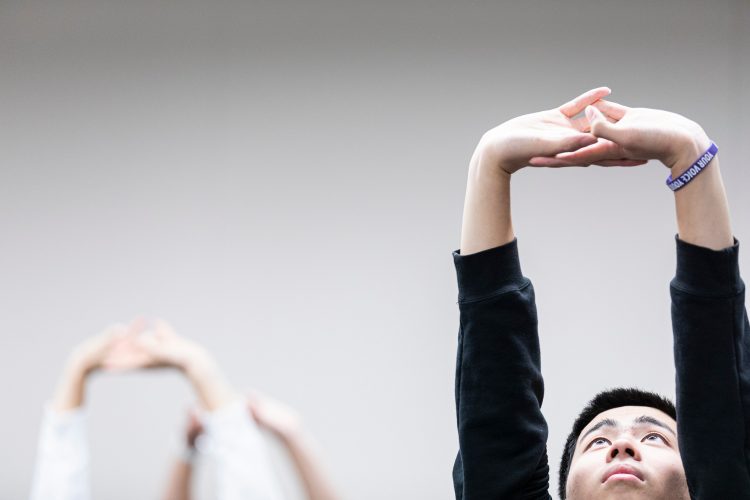
As somebody who is working in this domain of well-being, unless we are taking care of ourselves and really practicing… trying these things on and engaging [authentically]… it just doesn’t work. It doesn’t come across as something with sincerity that folks are going to actually listen to. But if we can come into conversations with each other, talking about how we’re grappling with our own well-being… Normalizing a lot of the challenges that we’re all facing ends up being, and has been, an incredibly healthy evolution for me. I’d say I’m probably oddly healthier right now that I was [before the pandemic]. It’s been a six-year meditation on resilience, coping, psychological and physical well-being, and intersections between issues of anxiety, depression, stress, and emotion.
SD: How do you feel the Resilience Lab could influence a massive institution like the UW?
AB: Similar to the inception of the lab, where we had that snowball effect of [the amount of people] who showed up, it was neat that it was a snowball of faculty from all different campus, all different academic domains. Those meetings felt like big extensions of that micro research meeting that we would have in the lab. And I think finding spaces where you can authentically say “I tried this, and it didn’t work, and I need some help to figure out what might have gone wrong, or what I could do differently”… it’s very rare to have those kinds of spaces.
We live in a pretty performative space, where you’ll go to a meeting, everybody shares everything that’s gone right, or talks about their programming… all of that we could just put in an email. The thing that we actually need is to create space to interact about “I tried this, I went out on a limb and it didn’t work. And now I need trusted colleagues that I can debrief this with and figure out what to try differently next time.” And I think if ethos of the Lab were to emerge in more spaces, I think we would see more conversations about [failure] and how we can do better.
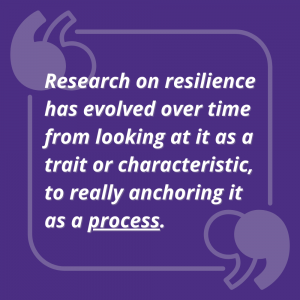 SD: How would you conceptualize the overlap between equity and well-being, both in terms of systemic well-being and individual well-being?
SD: How would you conceptualize the overlap between equity and well-being, both in terms of systemic well-being and individual well-being?
AB: I think it actually hits on one of the major challenges we’ve faced and even thinking about conceptualizing resilience as an organizing structure, around this work. I would say, when we started, “resilience” really exploded as a buzzword for the next several years. And we saw resilience used in some really challenging ways where there was this pushback from institutions and structures saying “Those kids, or those people, just need to be more resilient. They’re too fragile, they need all this individual attention. If they were just tougher, more resilient, they’d be able to cope with systemic racism and structural inequalities, like everybody else who’s come before them.”
It became a language of pushback against much-needed change. And it was great in that it really pushed us to get incredibly clear on what we meant by resilience and how we’re using that term, how we’re conceptualizing resilience in our systematic review… Research on resilience has evolved over time from looking at it as a trait or characteristic to really anchoring it as a process. And within that process, it’s about both internal and external resources that you can leverage in the context in which you are situated as a person, and how that affects your ability to experience resilience.
And that was a pretty key piece, thinking about it from an equity lens of who gets to fail and recover, and who doesn’t get to have that as an opportunity. Do we have an equitable sense of who gets to risk-take? Who gets to fail, and who gets to recover? So, it has to be two simultaneous buckets of work: one, how do we support individuals to develop more resilience coping skills, but two, as a lab, we have to advocate for changes within systems and structures.
We have to support folks in thinking about resilience coping, almost so that they can stay engaged in the incredibly hard work of advocating for systems change. We had a student tell us “If one more person tells me I need to self-care my way out of my own oppression, I’m going to lose it.” That was a really good encapsulation of what we intentionally have to be clear to avoid. 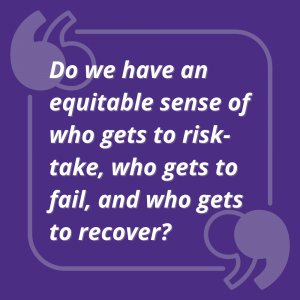
SD: What do you anticipate will be the next frontier of well-being in higher education?
AB: I can think of few spaces where the need is more dire to grapple with [well-being in education] more than the UW School of Medicine as it affects a five-state WWAMI (Washington, Wyoming, Alaska, Montana, and Idaho) region… getting beyond what needs to be learned for tests, and into how to engage in the humanity in medicine, supporting folks showing up as their whole self, even as a physician. It’s a domain that I’m really excited to dig into. I’m hoping that these conversations around well-being for life and learning across our medicine faculty will [create] a community of practice. We’ve seen folks across medicine spread ridiculously thin and they’ve been really impacted by their work during this time. How do we come up with what that recovery would look like, but also, how do we reimagine how we do this work? We have a chance to reimagine what medicine looks like in education.
Notes:
[1] Stereotype threat is psychological distress arising from the perception that one’s own behavior is confirming a negative stereotype about a marginalized group to which you belong.
